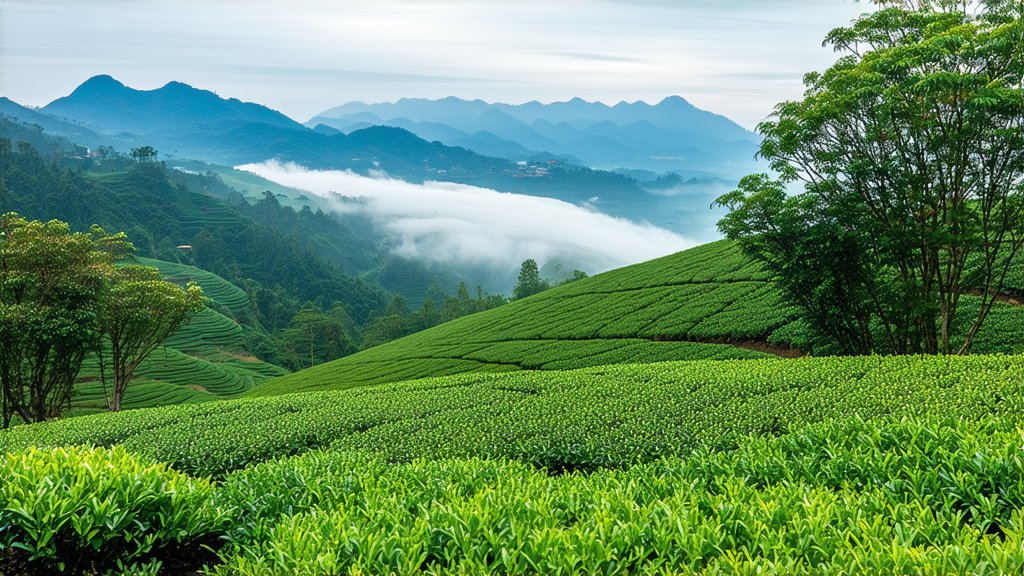
In the vast and diverse landscape of Chinese tea culture, few varieties capture the essence of tradition and craftsmanship quite like Huangshan Maofeng. This exquisite yellow tea hails from the picturesque Huangshan Mountains in Anhui Province, a region renowned for its breathtaking scenery and favorable climate for tea cultivation. With a history that spans over a millennium, Huangshan Maofeng is not just a beverage but a cultural treasure that embodies the artistry and heritage of Chinese tea making.
Historical Context
The story of Huangshan Maofeng begins in the Tang Dynasty (618-907 AD), a period marked by significant advancements in agricultural practices and cultural refinement. It was during this era that tea became an integral part of Chinese society, transcending its initial role as a medicinal herb to become a symbol of sophistication and elegance. The name "Huangshan Maofeng" translates to "Yellow Mountain Peak," a nod to its origin amidst the verdant slopes of the Huangshan range, which has long been celebrated as one of China's most beautiful natural wonders.
Varieties and Classification
Huangshan Maofeng belongs to the category of yellow teas, a lesser-known yet highly revered group within the Chinese tea family. Unlike its more popular counterparts, such as green and black tea, yellow tea undergoes a unique post-harvest process known as "menhuang" or "sedimentation." This involves steaming the freshly picked leaves briefly before allowing them to sit and oxidize under controlled conditions, resulting in their distinctive golden hue and mellow flavor profile.
There are several sub-varieties of Huangshan Maofeng, each with its own subtle differences in taste and aroma. The most prized among them is the "Core产区" or "Core Production Area" Maofeng, grown at higher altitudes where the cooler temperatures and mist contribute to a slower growth rate, enhancing the tea's complexity and depth. Other notable variations include "Monkey King" (Hou Wang) Maofeng, known for its playful curled leaves resembling monkey tails, and "Phoenix Nest" (Feng Huang Zhuo), characterized by its tightly wound, nest-like appearance.
The Art of Tea Making
The production of Huangshan Maofeng is a meticulous process that requires both skill and patience. It all starts with handpicking only the youngest, tenderest buds and leaves during the early spring harvest, ensuring optimal freshness and quality. These are then carefully steamed to halt enzymatic activity, preserving the tea's vibrant green color while initiating the oxidation process.
Next comes the critical "menhuang" stage, where the steamed leaves are spread out on bamboo mats or woven trays and covered to promote controlled oxidation. This step can last anywhere from 24 to 72 hours, depending on the desired level of oxidation and the specific characteristics sought after by the tea master. During this time, the leaves gradually transform into their characteristic yellowish color, developing a sweet, fruity aroma with hints of honey and nuts.
Once the ideal degree of oxidation is achieved, the leaves undergo a final drying phase, often done in the sun or using low-temperature ovens, to reduce moisture content and stabilize the tea. The dried leaves are then sorted and graded based on size, shape, and overall quality before being packaged for distribution.
Appreciating Huangshan Maofeng
To truly appreciate Huangshan Maofeng, one must engage in the ritual of Gongfu tea ceremony, a practice that emphasizes mindfulness, respect, and the art of slow enjoyment. Begin by selecting a traditional Yixing clay teapot or a clear glass vessel to fully appreciate the visual spectacle of the unfurling leaves. Rinse the pot with hot water to warm it up, then add approximately 3-5 grams of loose leaf tea per 150ml of brewing capacity.
Steep the tea in water heated to around 80-85°C (175-185°F) for the first infusion, typically lasting between 1-2 minutes. Observe the transformation as the leaves slowly sink and unfurl, revealing their true form and releasing their captivating fragrance. Subsequent infusions can be steeped for progressively longer periods, allowing the drinker to explore the evolving flavors and aromas with each cup.
When sipping Huangshan Maofeng, pay attention to its smooth, velvety texture and the harmonious balance between sweetness and a mild astringency. Note the subtle nuances of floral and fruity notes, complemented by a gentle earthiness that lingers on the palate. The finish should be clean, leaving a refreshing aftertaste that invites another sip.
Conclusion
Huangshan Maofeng stands as a testament to China's rich tea heritage, offering a window into the intricate world of yellow tea production and appreciation. Its journey from the misty mountaintops to the teacup encapsulates centuries of tradition, innovation, and an unwavering commitment to quality. For those seeking a deeper understanding of Chinese tea culture and a sensory experience unlike any other, Huangshan Maofeng is a must-try delicacy that promises to transport you to the heart of ancient China's tea-growing regions.